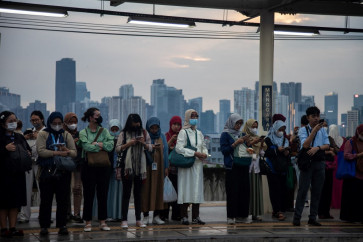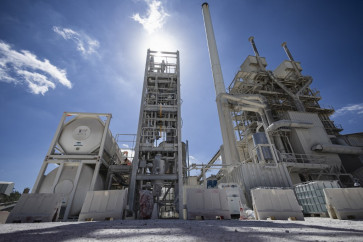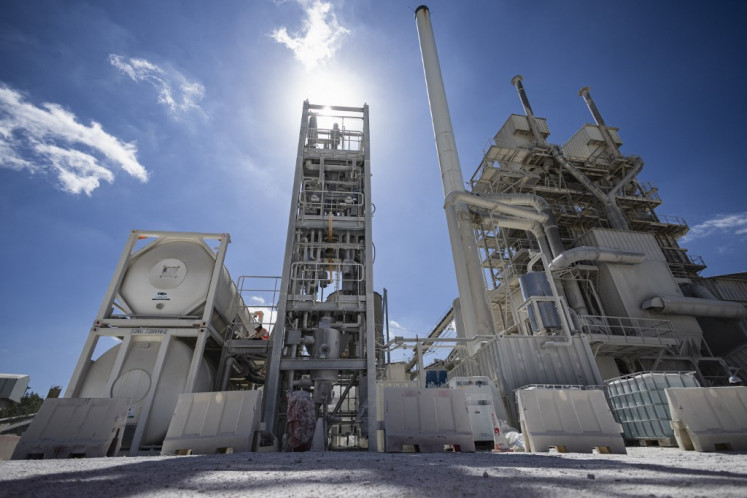Popular Reads
Top Results
Can't find what you're looking for?
View all search resultsPopular Reads
Top Results
Can't find what you're looking for?
View all search resultsVisiting the luxurious but not elitist Le Grand Musee du Parfum in Paris
Perfume has always been one of France’s luxury exports coupled with haute couture, cosmetics and the fine art of living. Approximately 400 new fragrances are created each year in the country, translating into annual revenues of 25 billion euros, making up 25 percent of the world’s production.
Change text size
Gift Premium Articles
to Anyone
 The museum offers technoligal innovaions to capture the elusive scents. Here these little balls all contain natural sources of fragrances like jasmine and orange blossoms. One takes up the ball after turning it to select the language so that one can listen to the explanation after actually smelling the scent. (Le Grand Musee du Parfum, Paris/File)
The museum offers technoligal innovaions to capture the elusive scents. Here these little balls all contain natural sources of fragrances like jasmine and orange blossoms. One takes up the ball after turning it to select the language so that one can listen to the explanation after actually smelling the scent. (Le Grand Musee du Parfum, Paris/File)
T
he etymology of the word perfume comes from the latin prefix per that means through or by, and fumare that means either smoke, vaporize or steam. Therefore, perfume is an agreeable emanation of a pleasant smell. Cleopatra, for example, had the sails of her ship fanned by the vapors of burning fragrant woods, thus heady scents preceded her actual appearance before Marc-Anthony finally met her in ancient Egypt.
Perfume has always been one of France’s luxury exports coupled with haute couture, cosmetics and the fine art of living. Approximately 400 new fragrances are created each year in the country, translating into annual revenues of 25 billion euros, making up 25 percent of the world’s production.
However, until recently there was no museum of perfume in Paris (apart from the Fragonard museum that solely concerns that company) dedicated to the history, methodology and artifacts connected to the olfactory essences that make up global historical scents and those perfumes present in contemporary France.
Guillaume de Maussion, now president of Le Grand Musee du Parfum, together with Sandra Armstrong, Dorothee Lepere and the recently deceased Nicolas de Gaulmyn, decided to remedy the lack of a perfume museum two years ago.
Monsieur de Maussion confessed, “I am like everybody: I adore perfume, but I noticed that I actually knew nothing about such a vast subject which is part of our daily lives. As I am curious about everything, I became very interested in perfume, how it is fabricated, and that is why I am so passionate about the subject.”
As luck would have it, the elegant historical townhouse in the courtyard opposite Hotel Bristol, close to the Elysée presidential Palace, was available. Christian Lacroix’s now defunct maison de couture was housed here in the luxurious 8th arrondissement situated in the Triangle d’Or (golden triangle). Additionally there is a large private garden space behind it. The garden will be planted with various aromatic plants and flowers such as vetiver (grown in Java), roses, iris and lavender to create a natural sensory environment.
(Read also: Rich have no room for ordinary trips)
 A garden behind the museum, where the aromatic garden will be planted next spring.(Le Grand Musee du Parfum, Paris/File)
A garden behind the museum, where the aromatic garden will be planted next spring.(Le Grand Musee du Parfum, Paris/File)
It took the original team two years to collect 7 million euros necessary to renovate and supervise the decor of the 1400 square meter, four-story building, which opened on Dec. 22, just in time for Christmas. Seminars and special exhibitions will be held on the top floor.
Besides the actual building, a scientific and cultural committee of experts helped to formulate the approach and technical know-how providing visitors with a strong interactive olfactory experience. They will begin to understand the sensory and scientific alchemy of perfume, and how smells and emotion are connected.
A contemporary perfumer or professional ‘nose’ managed to re-create one of the most ancient Egyptian medicinal fragranceskyphi dating from 1500 BC of which I took a strong whiff in the historical section. Further on there are oliban and myrrh ‘smelling bowls’. Visitors can learn to identify over 70 different fundamental olfactory notes on the second floor. Needless to say, I could not identify all of these, but did recognize nutmeg among others. It is recommended that the visitor take time to recover from each whiff in order to identify another odor.
Unfortunately the stylized rose-bush called blossom with five stems emanating five legendary rose-based perfumes was not yet ready, but one could have a sniff of the imposing bowl of freshly plucked roses beside it. Apparently a single rose is constituted of at least 400 odorous molecules. One can imagine how many petals have to be distilled to produce a single bottle of natural rose-based perfume.
There is a section where visitors can unscrew a metal bulb which gives information in five languages, besides emitting one of the basic olfactory notes like bergamot or jasmine. Here the visitor begins to understand the principle of layering essences to create a perfume, basically on three levels. In a traditional laboratory a ‘nose’ (creator of perfumes), like Jean-Claude Ellena, works to distill a new fragrance for a customer such as Hermes.
(Read also: Fantasy, history and shopping in London)
 Even more extraordinary is the organ of perfume devised by perfumer Jason Bruges that allows a laser to choose an ingredient from those available and combine it with various others in the bottle so as to have an idea of what an imagined perfume will actually smell. Thus aiding the olfactory sense of the perfumer.(Le Grand Musee du Parfum, Paris/File)
Even more extraordinary is the organ of perfume devised by perfumer Jason Bruges that allows a laser to choose an ingredient from those available and combine it with various others in the bottle so as to have an idea of what an imagined perfume will actually smell. Thus aiding the olfactory sense of the perfumer.(Le Grand Musee du Parfum, Paris/File)
The fascinating perfume organ created by Jason Bruges Studio visually and acoustically illustrates the usual conceptual method of combining chemical essences, manually arranged in shelves of small bottles called the perfume organ. Here the perfume organ is translated into musical notes and laser beams connecting the different elements of the novel composition by computer.
 The historical section is to be found in the cellar of the four storey building. Here we see Napoleon and Empress Eugenia, one pair of the famous couples with the explanation of what perfume they wore to seduce the other. Cleopatra for example besides perfuming herself with exotic oils actually perfumed the sails of her little ship by burning perfumed woods to fan the smoke so that this reached Marc-Aurelius before she even sailed into sight.(Le Grand Musee du Parfum, Paris/File)
The historical section is to be found in the cellar of the four storey building. Here we see Napoleon and Empress Eugenia, one pair of the famous couples with the explanation of what perfume they wore to seduce the other. Cleopatra for example besides perfuming herself with exotic oils actually perfumed the sails of her little ship by burning perfumed woods to fan the smoke so that this reached Marc-Aurelius before she even sailed into sight.(Le Grand Musee du Parfum, Paris/File)
The historical section, in the former cellar, also contains the seducers’ space where Cleopatra, here wittily depicted as Elizabeth Taylor by the painter, in reference to the movie, faces Marc-Anthony. The story of how she seduced him is described together with the ancient Egyptian ingredients. Napoleon faces Empress Eugenia, consort of Napoleon III, his descendant, where there is mention of her signature citrusy Imperial Cologne by Guerlain, among other perfumes she used.
Furthermore, signature bottles of famous scents, together with a sketched costume by the couturier, such as Coco Chanel and the famous square-shaped Chanel No 5, can be admired. Chanel No 5 was created by French-Russian chemist Ernest Beaux.
Remember Marilyn Monroe’s declaration that she slept naked except for Chanel No 5? Well you will not find her mentioned at the museum in Paris, but some visitors might remember that famous quote she made before her untimely death.
---------------
Interested to write for thejakartapost.com? We are looking for information and opinions from experts in a variety of fields or others with appropriate writing skills. The content must be original on the following topics: lifestyle ( beauty, fashion, food ), entertainment, science & technology, health, parenting, social media, and sports. Send your piece to community@jakpost.com. Click here for more information.










